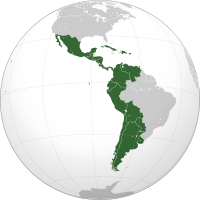
Photo from wikipedia
Background: The NCCN Clinical Practice Guidelines in Oncology recommend definitive therapy for all men with high-risk localized prostate cancer (PCa) who have a life expectancy >5 years or who are… Click to show full abstract
Background: The NCCN Clinical Practice Guidelines in Oncology recommend definitive therapy for all men with high-risk localized prostate cancer (PCa) who have a life expectancy >5 years or who are symptomatic. However, the application of these guidelines may vary among ethnic groups. We compared receipt of guideline-concordant treatment between Latino and non-Latino white men in California. Methods: California Cancer Registry data were used to identify 2,421 Latino and 8,636 non-Latino white men diagnosed with high-risk localized PCa from 2010 through 2014. The association of clinical and sociodemographic factors with definitive treatment was examined using logistic regression, overall and by ethnicity. Results: Latinos were less likely than non-Latino whites to receive definitive treatment before (odds ratio [OR], 0.79; 95% CI, 0.71-0.88) and after adjusting for age and tumor characteristics (OR, 0.84; 95% CI, 0.75-0.95). Additional adjustment for sociodemographic factors eliminated the disparity. However, the association with treatment differed by ethnicity for several factors. Latino men with no health insurance were considerably less likely to receive definitive treatment relative to insured Latino men (OR, 0.34; 95% CI, 0.23-0.49), an association that was more pronounced than among non-Latino whites (OR, 0.63; 95% CI, 0.47-0.83). Intermediate-versus high-grade disease was associated with lower odds of definitive treatment in Latinos (OR, 0.75; 95% CI, 0.59-0.97) but not non-Latino whites. Younger age and care at NCI-designated Cancer Centers were significantly associated with receipt of definitive treatment in non-Latino whites but not in Latinos. Conclusions: California Latino men diagnosed with localized high-risk PCa are at increased risk for undertreatment. The observed treatment disparity is largely explained by sociodemographic factors, suggesting it may be ameliorated through targeted outreach, such as that aimed at younger and underinsured Latino men.
Journal Title: Journal of the National Comprehensive Cancer Network : JNCCN
Year Published: 2018
Link to full text (if available)
Share on Social Media: Sign Up to like & get
recommendations!